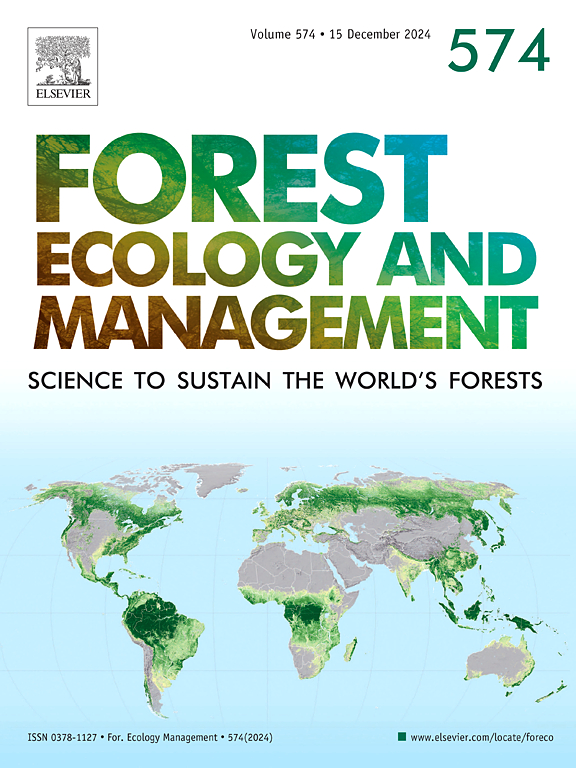Converting larch monocultures to mixed-species forests: Ten-year impacts of canopy manipulation on understory regeneration
IF 3.7
2区 农林科学
Q1 FORESTRY
引用次数: 0
Abstract
Larch (Larix spp.) monoculture plantations are widely used for timber production but often lead to reduced biodiversity and ecosystem functioning. Therefore, exploring strategies to transition these plantations into mixed-species forests while maintaining forest ecosystem sustainability is crucial. This study examines the ten-year impacts (2015–2024) of small-scale, low-intensity canopy manipulation on the growth performance of planted Manchurian walnut (Juglans mandshurica Maxim.) and Korean spruce (Picea koraiensis Nakai). Four canopy treatments were applied: control (no treatment), light thinning (25 % basal area reduction), smaller gaps (45 m²), and larger gaps (160 m²). We also compared artificial planting with existing natural regeneration under these treatments. Results indicated that both species primarily survived in gaps, with nearly all individuals in control and thinning treatments dying after 10 years. For Manchurian walnut, stems exhibited significantly greater height and root collar diameter (RCD) at gap centers, particularly in larger gaps, where height was 190 % greater than at gap edges. For Korean spruce, while RCD did not differ significantly between gap sizes, it was 16–21 % higher at gap centers compared to edges. Ecophysiological traits (i.e., specific leaf area, chlorophyll content, and non-structural carbohydrate concentration) were largely unaffected by gap size or within-gap position. Furthermore, the proportion of dominant species was higher in artificial planting plots (69 %) than in natural regeneration plots (57 %), while natural regeneration plots supported more common species (10 vs. 7). These findings highlight the efficacy of combining gap creation with artificial planting as a silvicultural approach to gradually transitioning larch monocultures into mixed-species forests.
将落叶松单植林转变为混交林:树冠控制对林下再生的十年影响
本文章由计算机程序翻译,如有差异,请以英文原文为准。
求助全文
约1分钟内获得全文
求助全文
来源期刊

Forest Ecology and Management
农林科学-林学
CiteScore
7.50
自引率
10.80%
发文量
665
审稿时长
39 days
期刊介绍:
Forest Ecology and Management publishes scientific articles linking forest ecology with forest management, focusing on the application of biological, ecological and social knowledge to the management and conservation of plantations and natural forests. The scope of the journal includes all forest ecosystems of the world.
A peer-review process ensures the quality and international interest of the manuscripts accepted for publication. The journal encourages communication between scientists in disparate fields who share a common interest in ecology and forest management, bridging the gap between research workers and forest managers.
We encourage submission of papers that will have the strongest interest and value to the Journal''s international readership. Some key features of papers with strong interest include:
1. Clear connections between the ecology and management of forests;
2. Novel ideas or approaches to important challenges in forest ecology and management;
3. Studies that address a population of interest beyond the scale of single research sites, Three key points in the design of forest experiments, Forest Ecology and Management 255 (2008) 2022-2023);
4. Review Articles on timely, important topics. Authors are welcome to contact one of the editors to discuss the suitability of a potential review manuscript.
The Journal encourages proposals for special issues examining important areas of forest ecology and management. Potential guest editors should contact any of the Editors to begin discussions about topics, potential papers, and other details.
 求助内容:
求助内容: 应助结果提醒方式:
应助结果提醒方式:


